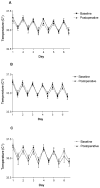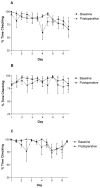Assessment of buprenorphine, carprofen, and their combination for postoperative analgesia in olive baboons (Papio anubis)
- PMID: 17487949
- PMCID: PMC2987732
Assessment of buprenorphine, carprofen, and their combination for postoperative analgesia in olive baboons (Papio anubis)
Abstract
This study compared the efficacy of buprenorphine, carprofen, and a combination of the 2 analgesics in female baboons. Physiologic and behavioral parameters were assessed at baseline and postoperatively for 6 d by use of continuous noninvasive physiologic monitoring and twice-daily videotaping. Prior to surgery, all animals received a pre-emptive dose of either 0.01 mg/kg buprenorphine intramuscularly, 2.2 mg/kg carprofen intramuscularly, or a combination of 0.01 mg/kg buprenorphine and 2.2 mg/kg carprofen intramuscularly. All animals in the carprofen (n = 4) and buprenorphine+carprofen (n = 4) treatment groups appeared to have sufficient analgesia. Three of 4 animals in the buprenorphine group had adequate analgesia. The fourth animal had an elevated heart rate and spent less time standing during the postoperative period. In this study, the use of carprofen or a combination of carprofen plus buprenorphine provided more reliable postoperative analgesia than buprenorphine alone.
Figures





Similar articles
-
Anti-nociceptive efficacy of carprofen, levomethadone and buprenorphine for pain relief in cats following major orthopaedic surgery.J Vet Med A Physiol Pathol Clin Med. 2005 May;52(4):186-98. doi: 10.1111/j.1439-0442.2005.00710.x. J Vet Med A Physiol Pathol Clin Med. 2005. PMID: 15882404 Clinical Trial.
-
Assessment of carprofen and buprenorphine on recovery of mice after surgical removal of the mammary fat pad.J Am Assoc Lab Anim Sci. 2010 Sep;49(5):610-6. J Am Assoc Lab Anim Sci. 2010. PMID: 20858363 Free PMC article.
-
The analgesic effects of buprenorphine (Vetergesic or Simbadol) in combination with carprofen in dogs undergoing ovariohysterectomy: a randomized, blinded, clinical trial.BMC Vet Res. 2018 Oct 5;14(1):304. doi: 10.1186/s12917-018-1628-4. BMC Vet Res. 2018. PMID: 30290820 Free PMC article. Clinical Trial.
-
Comparison between analgesic effects of buprenorphine, carprofen, and buprenorphine with carprofen for canine ovariohysterectomy.Vet Anaesth Analg. 2008 Jan;35(1):69-79. doi: 10.1111/j.1467-2995.2007.00352.x. Epub 2007 Sep 7. Vet Anaesth Analg. 2008. PMID: 17850228 Clinical Trial.
-
Comparison of morphine and carprofen administered alone or in combination for analgesia in dogs undergoing ovariohysterectomy.J S Afr Vet Assoc. 2006 Sep;77(3):120-6. doi: 10.4102/jsava.v77i3.358. J S Afr Vet Assoc. 2006. PMID: 17137051
Cited by
-
Challenges with Assessing and Treating Pain in Research Primates: A Focused Survey and Literature Review.Animals (Basel). 2022 Sep 5;12(17):2304. doi: 10.3390/ani12172304. Animals (Basel). 2022. PMID: 36078024 Free PMC article. Review.
-
Pharmacokinetics of Single-Dose Intramuscular and Subcutaneous Injections of Buprenorphine in Common Marmosets (Callithrix jacchus).J Am Assoc Lab Anim Sci. 2021 Sep 1;60(5):568-575. doi: 10.30802/AALAS-JAALAS-20-000151. Epub 2021 Jul 19. J Am Assoc Lab Anim Sci. 2021. PMID: 34281629 Free PMC article.
-
Pharmacokinetics of 2 formulations of buprenorphine in macaques (Macaca mulatta and Macaca fascicularis).J Am Assoc Lab Anim Sci. 2013 Jan;52(1):48-56. J Am Assoc Lab Anim Sci. 2013. PMID: 23562033 Free PMC article.
-
Evaluation of Analgesic Patches in Cynomolgus Macaques (Macaca fascicularis).J Am Assoc Lab Anim Sci. 2019 May 1;58(3):356-361. doi: 10.30802/AALAS-JAALAS-18-000101. Epub 2019 Apr 22. J Am Assoc Lab Anim Sci. 2019. PMID: 31010456 Free PMC article.
-
Development and validation of a cynomolgus macaque grimace scale for acute pain assessment.Sci Rep. 2023 Feb 24;13(1):3209. doi: 10.1038/s41598-023-30380-x. Sci Rep. 2023. PMID: 36828891 Free PMC article.
References
-
- Cambridge AJ, Tobias KM, Newberry RC, Sarkar DK. Subjective and objective measurements of postoperative pain in cats. J Am Vet Med Assoc. 2000;217:685–690. - PubMed
-
- Carlton SM, Lekan HA, Kim SH, Chung JM. Behavioral manifestations of an experimental model for peripheral neuropathy induced by spinal nerve ligation in the primate. Pain. 1994;56:155–166. - PubMed
-
- Chudler EH, Dong WK, Kawakami Y. Cortical nociceptive responses and behavioral correlates in the monkey. Brain Res. 1986;397:47–60. - PubMed
-
- Cooper BY, Vierck CJ. Vocalizations as measures of pain in monkeys. Pain. 1986;26:393–407. - PubMed
-
- Crews JC, Sehlhorst CS. Response to maintenance of tourniquet inflation in a primate model. Reg Anesth. 1991;16:195–198. - PubMed
Publication types
MeSH terms
Substances
Grants and funding
LinkOut - more resources
Full Text Sources
